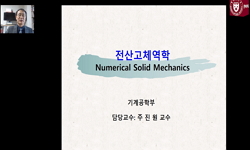The finite element analysis (FEA) is a numerical technique to find solutions of field problems. A field problem is approximated by differential equations or integral expressions. In a finite element, the field quantity is allowed to have a simple spat...
http://chineseinput.net/에서 pinyin(병음)방식으로 중국어를 변환할 수 있습니다.
변환된 중국어를 복사하여 사용하시면 됩니다.
- 中文 을 입력하시려면 zhongwen을 입력하시고 space를누르시면됩니다.
- 北京 을 입력하시려면 beijing을 입력하시고 space를 누르시면 됩니다.
https://www.riss.kr/link?id=A101828677
- 저자
- 발행기관
- 학술지명
- 권호사항
-
발행연도
2013
-
작성언어
English
- 주제어
-
등재정보
KCI등재
-
자료형태
학술저널
-
수록면
1-8(8쪽)
- 제공처
-
0
상세조회 -
0
다운로드
부가정보
다국어 초록 (Multilingual Abstract)
The finite element analysis (FEA) is a numerical technique to find solutions of field problems. A field problem is approximated by differential equations or integral expressions. In a finite element, the field quantity is allowed to have a simple spatial variation in terms of linear or polynomial functions. This paper represents a review and an accuracy-study of the finite element method comparing the FEA results with the exact solution. The exact solutions were calculated by solid mechanics and FEA using matrix stiffness method. For this study, simple bar and cantilever models were considered to evaluate four types of basic elements - constant strain triangle (CST), linear strain triangle (LST), bi-linear-rectangle(Q4),and quadratic-rectangle(Q8). The bar model was subjected to uniaxial loading whereas in case of the cantilever model moment loading was used. In the uniaxial loading case, all basic element results of the displacement and stress in x-direction agreed well with the exact solutions. In the moment loading case, the displacement in y-direction using LST and Q8 elements were acceptable compared to the exact solution, but CST and Q4 elements had to be improved by the mesh refinement.
목차 (Table of Contents)
- 1. Introduction
- 2. Numerical Methods
- 3. Evaluation of Finite Eelment Analysis
- 4. Conclusion
- Acknowledgements
- 1. Introduction
- 2. Numerical Methods
- 3. Evaluation of Finite Eelment Analysis
- 4. Conclusion
- Acknowledgements
- References
동일학술지(권/호) 다른 논문
-
Bar와 Beam 구조물의 기본적인 유한요소 모델의 수치해석
- 한국복합신소재구조학회
- 류용희 ( Yong Hee Ryu )
- 2013
- KCI등재
-
복합소재 기둥 구조의 적층배열 변화에 따른 고유진동 및 모드 특성
- 한국복합신소재구조학회
- 김규동 ( Gyu Dong Kim )
- 2013
- KCI등재
-
고속도로 하부 횡단 배수시설로 사용되는 파형 플래스틱 관의 덮개 요건
- 한국복합신소재구조학회
- 강준석 ( Jun Suk Kang )
- 2013
- KCI등재
-
주기하중을 받고 있는 금속의 시간의존적 소성 모델 비교
- 한국복합신소재구조학회
- 김동건 ( Dong Keon Kim )
- 2013
- KCI등재





 코리아스칼라
코리아스칼라






